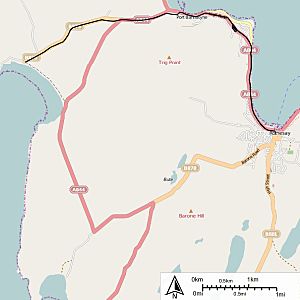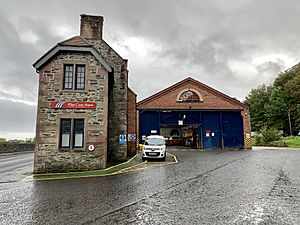Rothesay and Ettrick Bay Light Railway facts for kids

Map of Rothesay tramway
|
|
| Operation | |
|---|---|
| Locale | Rothesay |
| Open | 19 August 1902 |
| Close | 30 September 1936 |
| Status | Closed |
| Infrastructure | |
| Track gauge | 3 ft 6 in (1,067 mm) |
| Propulsion system(s) | Electric originally horse drawn |
| Depot(s) | Port Bannatyne |
| Statistics | |
| Route length | 4.87 miles (7.84 km) |
The Rothesay tramway was a special electric tram system on the Isle of Bute, Scotland. It was unique because it was the only public tramway ever built on a Scottish island!
It first opened in 1882. Back then, it was a horse-drawn tramway. Later, in 1902, it was updated to run on electricity. The tramway served the island for many years before it finally closed in 1936.
Contents
The Rothesay Tramway Story

On November 25, 1879, a company called Rothesay Tramways Co. Ltd. was created. Their goal was to build and run a tramway on the beautiful Isle of Bute. This tramway was very special. It was the only one of its kind on any Scottish island.
Building the tramway started in early 1882. By June, it was ready. There was a big opening party. However, the tramway had to close again quickly. This was because the Board of Trade, who checked safety, had not yet approved it. After their inspection on June 10, the tramway officially opened.
Horse-Drawn Trams Begin
The first trams were pulled by horses. They ran on tracks that were 4 ft (1,219 mm) wide. The route went from the promenade in Rothesay to Port Bannatyne. The track was about 2.37 miles (3.81 km) long. It had two tracks at the Rothesay end and a single track further along.
The first trams, numbered 1 to 8, were "toastracks." These were open-sided cars with canvas roofs. Trams 9 to 12 were enclosed, single-deck cars. Local builders also made more trams. James McBride built two in July, numbered 13 and 14. William Lauder added trams 15 and 16 in 1891, and 17 and 18 in 1894. Tram 19 arrived in 1897.
Becoming Electric
In 1899, a large company called British Electric Traction wanted to buy the Rothesay tramway. They wanted to change it to run on electricity. At first, the Rothesay Tramways company said no. But British Electric Traction kept trying. Finally, in 1901, they agreed to a deal.
Before the sale, the tramway company got permission to upgrade the system. They also negotiated to keep running the trams until 1936. This required talks with local councils. Once everything was approved, the tramway was sold in 1901. British Electric Traction bought the tracks, 19 trams, and 41 horses. The horse-drawn tramway stopped running on March 2, 1902. This allowed the big upgrade to begin.
Electrification Work
The company Dick, Kerr & Co. was hired for the upgrade. They removed the old tracks and sold them. New, narrower tracks were laid. These new tracks were 3 ft 6 in (1,067 mm) wide. Ten of the old horse-drawn trams were changed to fit the new tracks. They ran a temporary service starting May 17, 1902.
All the track work was finished by early June. The entire project was done by August. An official opening ceremony was held on August 13. But just like before, the Board of Trade had not yet approved the electric line. So, the electric trams did not start carrying passengers until August 19.
Rothesay was one of the few places in Scotland that made its own electricity back then. The tramway had its own power station. In the 1920s, the tramway even helped the town by selling extra electricity to the local council.
The new electric trams were mostly supplied by Electric Railway and Tramway Carriage Works. This company was set up by Dick, Kerr. They provided 15 of the first 20 trams. Ten were open "toastracks" that could seat 50 people. Five were "combination cars" with 46 seats. These were used in bad weather or winter. The other five open cars were made by Brush and seated 46 people.
Expanding the Route
In 1902, British Electric Traction bought another company. This company ran horse buses and cabs. They saw how many people traveled to Ettrick Bay. This made them think an extension to the tramway would be a good idea.
So, an extension was built from Port Bannatyne to Ettrick Bay. This new section was 2.5-mile (4.0 km) long. It ran on its own special path, not on public roads. Dick, Kerr & Co. built this line too. It opened on July 13, 1905.
The Ettrick Bay station had space for three extra trams. Six trams could load or unload passengers at once. Trams could go up to 25 miles per hour (40 km/h) on this special track. On public roads, they had to go slower. In the summer, concerts were held at Ettrick Bay. The tram company even sold tickets that included both the tram ride and the concert!
On January 1, 1914, the Scottish General Transport Company took over the tramway. This company was part of British Electric Traction. In the 1920s, motor buses started to become popular. They competed with the trams. The tramway company even started its own bus service in 1925. This bus service made good money. The future of the tramway became uncertain.
Tram Fleet
Here are some of the electric trams that ran on the Rothesay tramway:
- 1-10: Open "toastracks" built by Electric Railway and Tramway Carriage Works in 1902.
- 11-15: Single-deck enclosed trams built by Electric Railway and Tramway Carriage Works in 1902.
- 16-20: Open "toastracks" built by Brush Electrical Engineering Company in 1903.
Closure
On June 1, 1932, the company changed its name to Western Scottish Motor Traction Company. The Rothesay tramway finally closed down on September 30, 1936.
Today, the old tram depot in Port Bannatyne is still in use. It is now a garage for buses.

